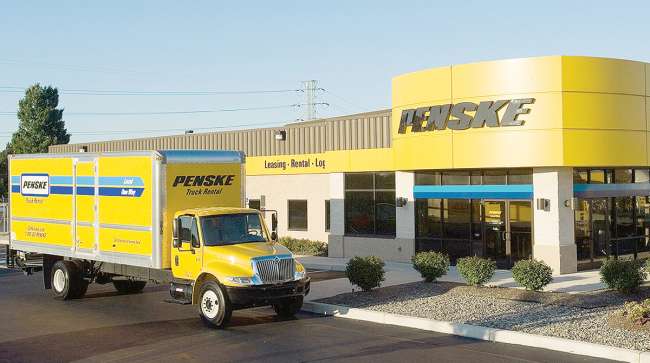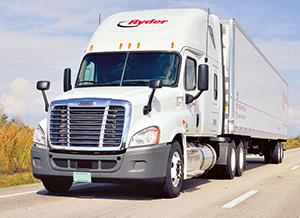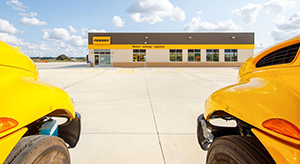Staff Reporter
Strong Freight Rates Drive Up Demand for Leased Trucks

[Ensure you have all the info you need in these unprecedented times. Subscribe now.]
The strong freight rates experienced by the transportation industry are driving an increase in truck leasing.
“The rebound in consumer spending from the economic shutdown coupled with the shift in expenditures to goods from services has resulted in tight capacity in the for-hire trucking industry,” Chris Brady, principal for Commercial Motor Vehicle Consulting, told Transport Topics. “Tight for-hire industry capacity swings the pricing pendulum to carriers from shippers resulting in higher freight rates.”
Brady added that the higher freight rates and tight capacity incentivize investments in trucks and trailers to meet the expanding freight volumes. He noted this also has resulted in more truck leasing and renting by for-hire carriers.

Ryder has seen strong rental demand. (Ryder System Inc.)
“The economic recovery has been uneven,” Brady said. “The truck population is made up of many industries that operate trucks, and not all industries have fully recovered. The for-hire trucking industry, particularly the general freight segment, has recovered from the recession.”
Ryder System Inc. has seen strong rental demand since the end of the second quarter, when spot rates started rising. Rental demand typically is an indicator that increased leasing is to come and the company already has started seeing that transition.
“Typically for us, elevated levels around spot rates means higher rental demand,” Joel Eigege, Ryder vice president and global product manager for rentals, told TT. “We also see customers come to us for leasing, but specifically to us our rental products will typically lead our leasing products.”
Ryder has a tractor fleet it can rent to customers at minimum to no capital investment. There also is more flexibility renting a truck as opposed to entering a more long-term contract. Eigege noted because of that, customers will tend to rent before leasing.
“We’re seeing improvements across the entire business, and all of our product lines, whether that be rental or leasing,” he said. “Customers will tend to rent first, get confident around their business and confident around the environment, before they go to lease.”
Eigege added that as quickly as spot rates go up they can go down. He noted the one wild card is the coronavirus pandemic and the possibility of that resulting in more shutdowns.

Penske has seen a surge in first-time lease customers. (Penske)
“Any time there is strong demand and freight rates are high, people are looking for supply, and we are a reliable and quick supply solution for equipment,” Jim Lager, Penske Truck Leasing senior vice president of sales, told TT. “We cannot provide specific numbers, but we can say that new business is certainly up, and we have seen a surge in first-time lease customers who are looking to take advantage of the benefits that leasing provides.”
Ryder reported that revenue for its leasing segment increased during the third quarter to $788.2 million from $766.2 during the previous quarter. The segment revenue also was up 2% from $770.7 million in the 2019 period.

Rush Enterprises reports that the lease and rental fleet is fully financed. (Rush Enterprises)
Rush Enterprises said in its third-quarter earnings report that the lease and rental fleet is fully financed with most customers under a long-term lease arrangement over renting. The lease and rental segment revenue increased to $57.9 million compared with $57.3 million from the previous quarter. It still was down year-over-over.
“The shrinkage in capacity over the past 12 months has created a classic supply-and-demand dynamic,” Jim Griffin, Fleet Advantage chief operating and technology officer, told TT. “Because of this, economic recovery capacity demand has increased. The diminished capacity has created a premium on supply, further triggering freight rates that are typically very cyclical and dynamic to increase.”
Griffin added that the increase in freight rates initially will attract owner-operator segments of the market that primarily rely on used trucks. Larger carriers will then begin to order new trucks when they become convinced the upward movement in capacity demand and rates are sustainable.
“This is also being translated into leasing,” Griffin said. “Leasing in general provides the ability for organizations to preserve cash and take advantage of the flexible leasing structures.”
Preliminary NA Class 8 net orders in November were 51,900 units, up 33% from October and a 197% improvement from year-ago November.https://t.co/cQ1UQT9Xku#truck #semitruck #trucking #transportation pic.twitter.com/84oRWpAlYo — ACT Research (@actresearch) December 4, 2020
ACT Research reported Dec. 2 that overall truck orders were up for November. North American Class 8 net orders increased 33% from the previous month to 52,104 units. That also represents a 197% improvement from the year-ago period.
Want more news? Listen to today's daily briefing:
Subscribe: Apple Podcasts | Spotify | Amazon Alexa | Google Assistant | More



